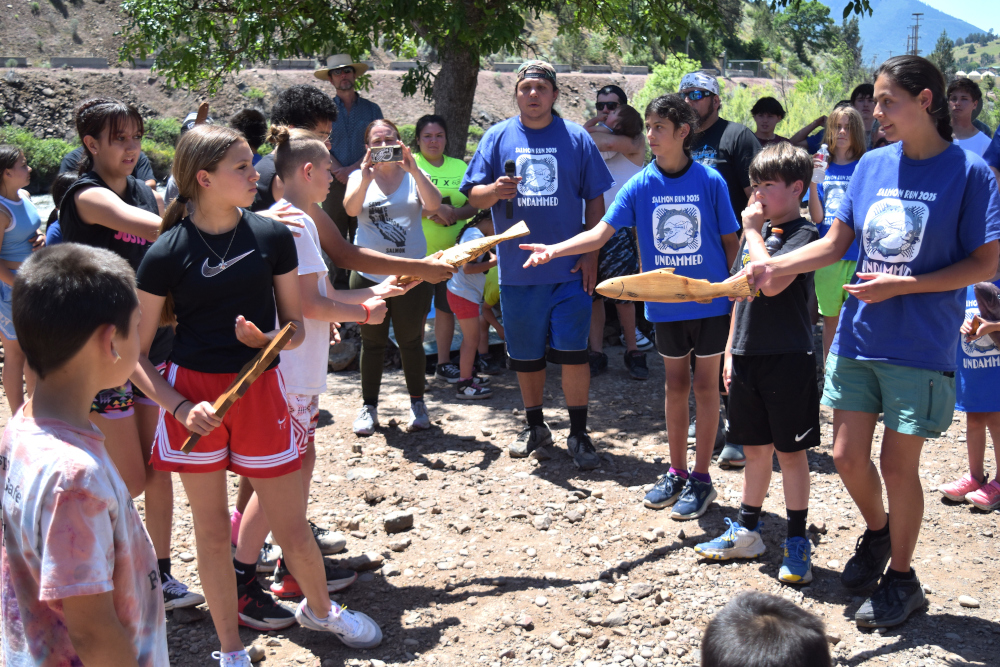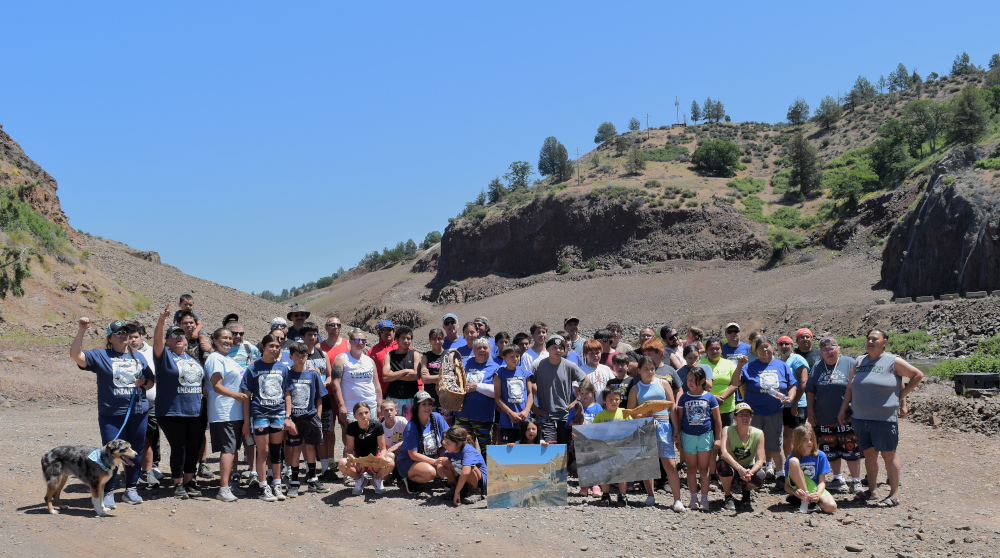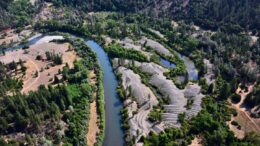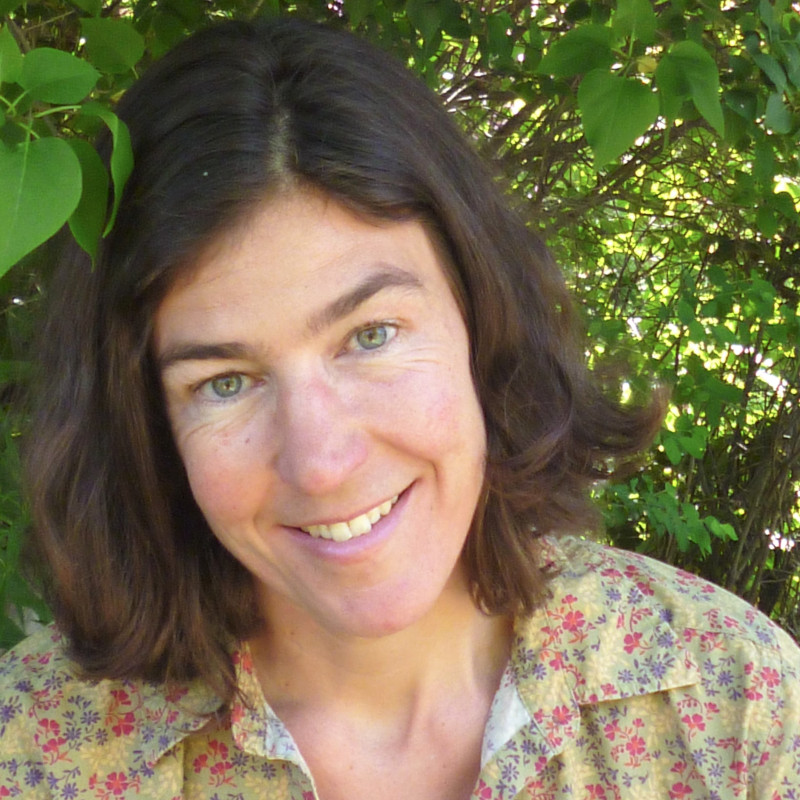On a Saturday afternoon in late May, Dania Rose Colegrove stood in the shade of an oak tree, waiting for a small group of young runners to crest the hill on a dusty dirt and gravel road.
She and about 60 Tribal members and river advocates had gathered on the banks of the Klamath River near the old Iron Gate dam site in northern California to witness the annual Salmon Run, which follows the migration route of salmon up the Klamath and its largest tributary, the Trinity River. In past years, the race ended abruptly at Iron Gate dam, and runners would shake their fists at the enormous earthen barrier.
This year, the mood was buoyant: for the first time, runners were about to race through an undammed stretch of the Klamath River.

“It’s been a long time coming, but it happened,” said Rose, a Hoopa Valley Tribal member and long-time activist for dam removal.
Four young women from the Hoopa Valley Tribe started the relay race more than 20 years ago to raise awareness about struggling salmon runs and to pray for the river’s healing.
Now that four dams have been completely removed from the main stem of the Klamath, Tribes and fish advocates are hopeful that water quality and fish runs can recover. But they know the work is just beginning — not just on the Klamath, but its tributaries.
“The Trinity River might be our next fight,” said Rose.
View this post on Instagram
The Trinity River is arguably the Klamath watershed’s most important artery. Historically, it teemed with salmon and steelhead and poured clean, cold water into the main stem Klamath. But for over seven decades, dams have blocked 100 miles of habitat on the tributary, and enormous volumes of water are diverted to an entirely different watershed. An ambitious restoration program is improving habitat and how the river flows, but climate change, over-allocation, and the unpredictability of the Trump administration threaten the river’s recovery.
An Artificial Tributary
Like every California water story, the story of the Trinity River is complicated.
The tributary flows through wild, mountainous Northern California for 165 miles before joining the Klamath River on Hoopa Valley and Yurok homelands.
It’s a fishy river, hosting several runs of steelhead, spring run and fall-run Chinook salmon, coho salmon, green sturgeon, Pacific lamprey, and eulachon.
Like other rivers in Gold Country, dredge mining thrashed the Trinity. In places, you can easily spot the tailings — enormous piles of river-rounded cobbles — that were scooped from the river, sifted through for gold, then dumped beside the banks in the 1930s and 40s.
In the 1950s Congress incorporated the Trinity River into the Central Valley Project, a massive and complex federal water project that supplies irrigation water to Central Valley agricultural land to the southeast. By 1963 three dams, diversion tunnels, and canals were completed, allowing the Central Valley Project to divert up to 90% of Trinity River water away from the Pacific Ocean and into the Sacramento River — an entirely different basin that eventually drains into San Francisco Bay.
Some argued fish runs might benefit from the changes. Young fish aren’t super-strong swimmers, the logic went, so they’d thrive from reduced water flows.
Instead, runs crashed.
The same act of Congress that married the Trinity River with the Central Valley Project also mandated that fish and wildlife on the Trinity be preserved, and that enough water flowed to serve people downstream.
“These provisions are being continually reinterpreted,” says Kyle DeJuilio, senior fisheries biologist at the Yurok Tribe. “And that has resulted in a lot of restoration activities and flow operation changes to try to reverse some of the damage that was done to the fish runs of the Trinity.”
Flowing From the Science
Consistent funding has allowed biologists to continually study the river and adapt management.
One thing they’ve learned: disturbance is good.
Before the dams and diversions, the Trinity River fluctuated wildly, swelling with winter storms, ebbing in the summer. Those big storms did good work, occasionally stripping away swaths of streamside trees and shrubs and spreading out into the floodplain, where gushy wet meadows supported a banquet of fish food for young salmon. The big, flushing flows also washed fine sediment out of the holes and riffles where adult salmon like to spawn.
After the dams were built, flows were managed at a steady state — lower in winter, higher in summer. Without disturbance, shrubs and trees grew thick along the riverbank.
The tamed river “become a really, really fast canal,” says DeJuillio. The vegetated berms also blocked fish from the floodplain, or stranded fish behind it.
To remedy these issues, managers used heavy equipment to physically turn the stream bed over and re-sculpt parts of the river channel. By the 1990s the spawning beds had recovered. But flows still weren’t strong enough to dislodge streamside vegetation or knock through the enormous piles of mining tailings.
In 2000 a federal decision created the Trinity River Restoration Program, which is managed by Tribes, the Bureau of Reclamation, and other government agencies and aims to restore fish runs to pre-diversion levels.
View this post on Instagram
The approach to restoration has evolved over the decades, says DeJuilio.
“River restoration was a really new and novel field of study in the nineties,” he explains. “In a way, we were focused [more] on the physical nature of the system and less on creating those really, really productive conditions at the time when [salmon] fry were present.”
The Oregon Gulch Project, completed in 2024, illustrates this new approach on a massive scale. Here, operators hauled thousands of cubic yards of mining tailings to a nearby quarry and used heavy equipment to sculpt a new meander across the valley. The newly created floodplain should be a haven for young salmon.
But habitat restoration is just one piece of the Trinity River puzzle.
More Water for the Trinity
In fall 2002 at least 34,000 salmon, mostly adult Chinook who had returned to the Klamath River to spawn, died near the river’s mouth after two highly contagious diseases ripped through the population. Warm water temperatures, which favor pathogens, contributed to the catastrophe.
Since then managers have occasionally released cold Trinity River water to keep temperatures in the Klamath from climbing too high and preventing another disastrous fish kill. But in drought dry years, there simply isn’t enough water in the Trinity to meet all of the demands.
Since the early 2000s, more water has stayed in the Trinity, yet on average, half of the river’s volume is still diverted to the Central Valley. In critically dry years, the percentage is often much higher. In 2024 the conservation organization American Rivers included the Trinity River in its list of most endangered rivers due to “outdated water management that has led to reservoir depletion, rising river temperatures, and other environmental impacts” that threaten fish.
The Hoopa Valley and Yurok Tribes are working with the Bureau of Reclamation on a new federal management plan for the Trinity River. Advocates hoped it would be completed last year.
Now, Rose worries how the plan might change under President Trump’s watch. Trump has demanded that water be diverted from northern California, where he claims (without merit) that it is “wasting” into the Pacific Ocean, to feed cities and farms to the south.
“When this Trump stuff comes down the track, I don’t know what’s going to happen,” says Rose.
Regina Chichizola, executive director at Save California Salmon, says state water plans also threaten the Trinity. For example, California Governor Gavin Newsom wants to expedite construction of the Delta Conveyance Project, a controversial proposal that has seen several incarnations over the decades. The “Delta tunnel” would bypass the San Francisco Bay Delta, allowing greater export of water from Northern California to the south during wet years.
Chichizola worries that this and other state plans leave the Trinity River vulnerable.
“There’s nothing to say that they can’t just take more water,” she says, pointing to drought years when the state would draw more water from Trinity River reservoirs to make up for low flows on the Sacramento River.
Her group and others are lobbying for explicit protections for the Trinity.
“Our biggest strategy for a while has been that we need California to put in place protections in all of their plans for the Trinity River,” she says.
This will be especially important as climate change accelerates: The next dry year is not an if, but a when.
But droughts aren’t the only concern, and it’s not just fish that are threatened.
Climate change will also bring bigger floods, and “Trinity dam is dilapidated and deteriorating,” says Rose. An analysis of California dams in the face of climate change revealed the two Trinity River dams as among the most at risk of failing, or overtopping, which would spell disaster for communities downstream.
As the Trump administration and Elon Musk’s DOGE gutted federal agencies earlier this year, critics sounded the alarm over how the cuts could compromise safety and management of dams nationwide.
Growing Bigger Fish
When it comes to supporting salmon, DeJuilio stresses that timing of water is just as important as the volume. Here again, science has been informing management.
Starting in 2000, the Restoration Program began releasing pulses of water from the dam in late spring in an attempt to mimic the river’s natural variation. But there’s a problem with this strategy. The water, released from the bottom of the dam, is frigid. The cold water confuses young salmon, who are already heading for the ocean. It also slows their growth.
The Trinity River produces about double the young salmon it did 20 years ago. But the fish are slightly smaller than they were in the past, and the number of adult Chinook returning from the ocean to spawn remains persistently low.
Program biologists want to start releasing this “extra” water from the dam earlier, in sync with winter storms in December, January, and February. These bursts of water would disturb the riverbed, creating conditions that allow yummy bugs to flourish and multiply at the right time of year.
“And the timing of that is almost perfect for when juvenile salmon are exiting the gravels [where they hatched],” says DeJuilio.
So far, this strategy has only been implemented twice, in 2023 and 2025, and it will take several fish generations to see if these “variable flows” translate into bigger, healthier fish.
The Hoopa Valley Tribe has sued to stop the winter releases of water — not because they think it’s a bad idea, but because they’re worried it wouldn’t leave enough water in reserve to bring down temperatures in the Klamath River in summer.
“I think it’s great that [the Restoration Program is] trying to release the water at the right times of year,” says Chichizola. “I just think it’s that they need more water to work with.”
The Restoration Program remains committed to the strategy.
“As with all water issues in California, it’s been highly debated and it’s been in the works for a long time,” says DeJuilio. “But generally, management is moving toward being ever better informed by the science and of what fish actually need.”
Running for the River
Back at the Iron Gate site on the Klamath River, a small crowd circled around as runners from the downriver Tribes exchanged wooden salmon totems with runners from the Klamath Tribes. Then they gathered for a group picture just downstream of where the massive earthen dam used to block the river.
“Undammed!” some of the elders shouted as cellphone cameras captured the scene.

Now that the barrier is gone, salmon can swim freely upstream. A more naturally flowing river should also reduce the risk of disease downstream, which hopefully means better survival of the fish that return up the Klamath and tributaries like the Trinity.
Dania Rose will keep advocating for the rivers, but she knows she can’t do it alone.
“I’m glad to see all these kids,” she says, as the young runners chug up the hill past the old Iron Gate site. “We need to pass the torch.”


Previously in The Revelator:
‘Like a Dead Zone’: Undoing Decades of Environmental Harm on a California River


